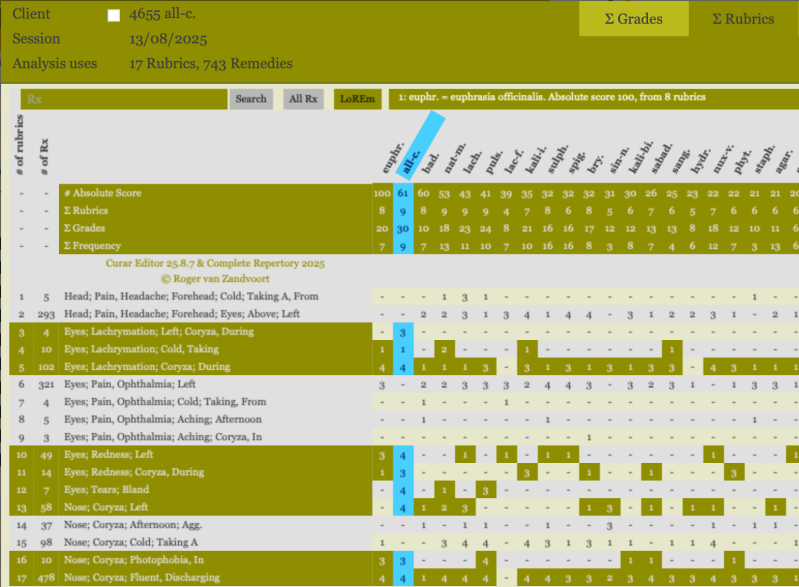
British homeopathic review, 1907, volume one, page 223. Clinical cases, Berridge
CASE 6.—Allium cepa. -December 19th, 1877-—The Rev. A. J., aged between 50 and 6o, caught cold during the first week in December, resulting in frontal pain, lachrymation, pain in left eye, weakness, and loss of appetite; for these symptoms he took sepia. On 14th he went out of doors in a cold wind. His cold improved, but eye became worse. On 15th had pain and lachrymation of left eye, with running from left nostril; he took Euphrasia with relief. On 16th, at noon, the pain returned, with water from left eye and left nostril; this lasted till 7 p.m., then ceased. On 17th the symptoms returned, at 12 or 12.30 p.m.; again he took Euphrasia, and in the evening they suddenly ceased. Yesterday the attack came on at 1 p.m., lasting till 5 p.m., then decreasing. Today, eye felt nearly well in morning, except photophobia; there had been a little lachrymation during night. At 1 p.m. aching pain came on in left eye and left brow ; after thirty minutes, bland lachrymation, heat, and redness of left eye, with running from left nostril; this lasted till 5 p.m., then decreased.
Diagnosis of the remedy. —The periodicity of the symptoms and the time of their inception, were here very characteristic; but the Materia Medica contained no simillimum. Another aspect of the case had, therefore, to be taken as the keynote or starting-point in the selection of the remedy. There was little characteristic in the symptoms themselves; but in their combination was found the solution of the homoeopathic equation : the ophthalmic were conjoined with nasal symptoms.
With coryza; left eye, lachrymation. Allium-cepa, arsen., aur-mur. (spirting out), calc.-sulph., carb.-veg., carbol.-ac., zinc. — redness. Allium-cepa., arsen., aur.-mur., zinc.
_ photophobia. Allium-cepa, zinc.
The choice now lay between allium-cepa and zinc, the former of which alone has catarrhal symptoms from exposure to cold wind (79, 80, 403). I prescribed one dose of allium-cepa 200 at 6.30 p.m.
December 2oth. -No redness, nor return of paroxysm; not the slightest pain to-day till 2.30 p.m., and then very slight; a little lachrymation at times.
December 21st.—No paroxysm, but only a little pain in eye about 1 p.m., and less than yesterday; feeling of lachrymation, and still a little photophobia.
December 24th.—Much better. The eye remained a little sensitive to cold air for a few weeks, but subsequently recovered.
Comments.—(1) This case illustrates the value of concomitant symptoms in the selection of the simillimum, but too much importance must not be attached to them. In Wirkungen des Schlangengiftes, 1837, Hering says: "Care should be taken not to adopt the notion that a remedy can cure groups of symptoms in a patient only if they occur in the order in which it produces them; it is capable of curing groups which it does not produce in the same combination at all; whose component parts were observed in a number of different provers, and frequently in quite a different order." The comparative value of the concomitants may be determined thus: if they are essentially concomitant, one symptom being really the cause of the other (e.g., lachrymation being caused by a general catarrhal condition), then this feature of the case must be considered ; but if no such relation of cause and effect is apparent, the concomitance of the symptoms may be disregarded excepting as it may serve to decide the choice between two or more remedies which equally produce the symptoms of the patient.
(2) The remedy was given when the severity of the paroxysm had passed off. Hahnemann has given no such rule with regard to periodical neuralgia: but in the Organon, pp. 236-7, he strongly warns us, in the case of ague, to give only one dose, and that immediately after, or towards the close of, the paroxysm. Analogy, therefore, leads us to observe the same rule with regard to all periodical diseases; and this is an illustration of progressive Homoeopathy; not building on another foundation than that laid by Hahnemann, but merely adding another stone to the temple, fully in harmony with its original design. In gynecological cases, unless there are acute symptoms demanding immediate relief, I find it advisable to commence the treatment, or to prescribe a new remedy, just after the menses; I have seen severe medicinal perturbation arise when this rule was neglected.
(3) After the single dose of allium-copa, the pain returned later, and very much less severe. In the treatment of all periodical diseases, if, after the administration of the remedy, the next paroxysm is later and less severe, it shows that the cure has commenced; also if it comes on earlier and more severe, it is merely a temporary medicinal aggravation, and the remedy must be allowed to act undisturbed, without either repetition or change. This rule I have frequently verified in various forms of disease.
(4) When in India this patient had ague, suppressed by large doses of quinine. I have observed that such an occurrence will sometimes impress a periodical diathesis (so to speak) upon the system, so that his various ailments will from time to time manifest this type. Frequently when an accident occurs to a patient who has suffered from ague, especially in tropical climates, and not been radically cured by homeopathy, a fresh attack of ague comes on; in these cases, therefore, a rigor is not necessarily a sign of incipient pyaemia.


Add comment
Comments
Thanks the practical inputs and informations